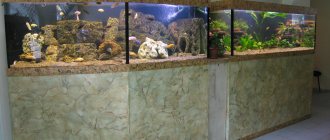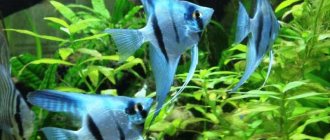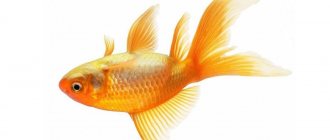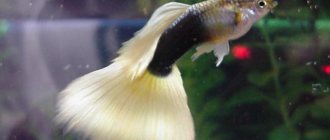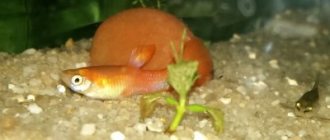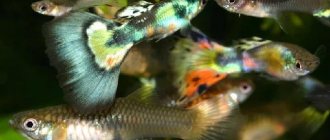Description
It reaches a length of 8–12 cm. The labyrinthine respiratory organ allows the animal to breathe air. Lives in bodies of water with low oxygen content, such as ponds, swamps and rice fields. Listed in the Red Book.
Appearance
The body of the macropod is oblong, flattened laterally. The fins are pointed, the long tail is forked. The fins on the abdomen are thread-like. The coloring is bright: blue and red stripes alternate on the body, the fins are also red-blue and shimmer in the light.
View this post on Instagram
Round tailed paradise fish#fish #fishtank #river fish #Macropodus ocellatus #biotope #aquariums #nature #layout #paradise fish
A post shared by SeungYoung Choi (@nark_choi) on Apr 10, 2021 at 7:13pm PDT
Behavior
Macropods have a difficult character. Males are very aggressive towards each other and other fish. Females are more tolerant of their tankmates. Good parents.
Lifespan
With good care, macropods live up to 8 years.
Habitat
Macropodus was noticed and recorded as a species by Carl Linnaeus at the end of the 18th century, and the first fish began to be brought to Europe in the mid-19th century from the south-eastern reservoirs of Asia - the place of origin of the fish. Russians became acquainted with fish only in the 20th century.
Today, populations of individuals can be found in slow-moving or standing waters, swamps, ponds or ditches in North America, in the rice fields of Korea, China, Japan, Vietnam, the islands of Taiwan and Madagascar.
Kinds
There are several color forms and types of labyrinths. The maintenance and care of different types of macropods, as well as the conditions of compatibility, are identical.
Classical
The homeland of the classical macropod is China. The body is olive or brown. On the abdomen and in the head area there are blue spots with vertical brick-red stripes. The common macropod has different color options:
- Blue. At the back the color turns purple.
- Albino. The body of the macropod is white with yellow stripes and pink fins. The eyes are reddish.
- Red smooth. The body is brown, the head is blue. The fins are red, the stripes on the body are almost invisible.
Redback
Species described in 2002. Silver in color with reddish fins and back. The scales shimmer beautifully in the right lighting. The tail and dorsal fin are blue with a white edge.
Black
The fish is native to Vietnam, but previously it was believed that the black macropod lives in the waters of Indonesia. Color dark gray or brown. The tail of males is dark crimson. They are distinguished by a shy and more tolerant character.
Chinese
Second name: round-tailed. In captivity, it lives only 4 years. In winter, the Chinese macropod requires a decrease in temperature to 10–15 degrees. Susceptible to microbacteriosis (fish tuberculosis). Not common among Russian aquarists. With a classic macropod it produces hybrid sterile offspring with an inconspicuous color.
Macropod standard
In 1976, a macropod standard was published in Germany, which can still be used today; it is suitable for fish with striped coloring
- Pre-assessment - the fish must be healthy, the male is at least 10 cm, the female is at least 8 cm.
- Evaluation (a pair of fish is evaluated)
- Size – up to 10 points
- Shape (slender, not high back) – up to 10 points
- Fins (whole, without damage, they must be proportionate to the body of the fish, as long as possible, but not interfering with swimming, at the end of unpaired fins there must be threads of at least 1 cm) The dorsal fin must extend to the middle of the caudal fin - up to 15 points .
- The anal fin should extend to the end of the caudal fin - up to 10 points
- The caudal fin must be wide and lyre-shaped, a strong difference in the length of the rays is penalized - up to 20 points
- Pelvic fins must be no less than the height of the body - up to 5 points
The maximum number of points is 100.
Based on this standard, one should take a critical approach to the breeding and selection of pairs and thereby prevent the next degeneration of the macropod.
Content
Macropod is a fish suitable for a small aquarium. Hardy, able to live in extreme conditions.
Aquarium
One fish can be kept in an aquarium of 20 liters or more. For a couple of individuals you will need an aquarium of at least 40 liters. A lid is required, because macropods are prone to jumping out of the water. For each fish, create one large shelter on different sides of the aquarium, so the cohabitants will occupy their own territory.
Water parameters
| Temperature | 16–26 degrees |
| Acidity | 6–8 |
| Rigidity | 5–19 dGh |
| Water movement | weak or absent |
Change 20-25% of the fluid weekly. Do not allow fish to settle in unsettled water. Check the hydrochemical composition of water with tests.
Plants
Place floating and plants with strong root systems:
- hornwort;
- duckweed;
- Java moss;
- pistia;
- salvinia;
- Echinodorus;
- Vallisneria;
- Cryptocoryne.
Plants floating on the surface of the water should not block access to oxygen, so periodically thin out the greens.
Priming
Choose a dark substrate, because the macropod looks advantageous against a dark background. In addition, dark soil does not irritate fish. Boil the soil before placing it in the aquarium. Be careful with artificially colored stones. Dyes may be toxic. Clean the soil with a siphon once a week.
Equipment
Of the devices, a macropod needs a low-power filter that does not create strong water movement. A compressor and heater are not necessary, since the paradise fish is comfortable even at 18 degrees. Aeration of water is required if the aquarium contains other fish that are not adapted to breathe air.
Lighting
Select lighting based on the needs of aquarium plants. Bright light is undesirable. Turn off the lights at night; there should be no more than 12 hours of daylight. Do not allow sunlight to shine on the walls of the tank. Make sure that the lamps do not heat the water too much. Remember that incandescent lamps have the highest heat output.
Varieties
There are four types of fish living in aquariums:
Macropodus opercularis
Divided into several subspecies:
| Name | Color |
| Classical | The coffee-colored body with greenish-blue stripes smoothly transitions into a deep blue tail, the head and belly are light blue. |
| Blue | Light blue body, purple head and back. |
| Albino | The white body has orange stripes, red eyes, and pinkish fins. |
| Red smooth | The head is blue, the body is brown, there are practically no stripes, all fins are red, except the pectoral ones, they are colorless. |
| Orange | The color matches the name. |
Black Macropod
It got its name because it takes on a charcoal hue when severely irritated. In a calm state, the color of the fish is gray or brown. The caudal fin is red, blue or pink. The individual is large in size, rarely found in its natural form, and most often sold as hybrids. More friendly than other varieties.
Redback
Has a characteristic body shade. The main color of the fish is silver, and under special lighting it shimmers with emerald undertones. The edges of the sky blue fins are outlined in rich white. In this species it is difficult to distinguish a female from a male; they are almost identical in color and size.
The only difference is the splendor of the male pectoral fins and tail.
Chinese (Round-tailed)
Macropod is rare in Russia. A capricious pet requires a temperature drop in winter to +15 °C. No neighbors can stand this. Life expectancy is only 4 years. Prone to bacterial diseases.
Care
These creatures are very unpretentious. But if you let life in the aquarium take its course, they will turn from paradise fish into faded, unattractive fish. If you do not want such a turn of events, then it is better to try and create the most comfortable conditions for macropods. What you will need:
Aquarium. Its volume for a couple should be at least 10-20 liters, and optimally 40 liters. In small containers, these chordates can live without problems, they just will not grow to their full size. It is better to cover it from above, as fish can jump out. The glass or lid should not fit tightly, as the macropods rise to the surface to breathe. The recommended distance from the water to the lid is 5-6 cm.
The water should have a temperature of 20-25 degrees, hardness 5-25, acidity 6.5-8. Macropods are able to withstand short-term temperature fluctuations from 10 to 35 degrees. If they are not kept in a common aquarium, but separately, then aeration and filtration are not needed. If filtration does occur, then strong currents must be excluded. It's not bad to make weekly 20-25 percent changes.
The light should be such that it ensures good growth of plants.
Coarse sand, small pebbles, fine gravel or expanded clay are suitable for the soil. Dark is better. The thickness of its layer is 5 cm.
You will need a lot of plants. They should be planted in the ground (vallisneria, hornwort, pinnate) and placed on the surface of the water (riccia, duckweed, pistia, nymphea). The female will especially need thickets to hide from the raging male and during the spawning period.
The decor consists of various driftwood, grottoes, etc. It’s better to choose those that can also serve as shelters. Unscheduled spawning: or breeding macropods
I rarely place macropods for spawning. They already regularly breed in common aquariums, and I simply take the nest with eggs, catch the male and transplant them all into a spawning tank, into which I pour water from the same common container. The male usually immediately restores his air lock that was damaged during transfer, collects the eggs that have fallen to the bottom and begins to care for them as if no transfer had ever taken place.
I don’t feed the male while caring for the offspring, and I don’t leave the light on at night - he copes just fine without it. Yes, I have seen recommendations in the literature about night illumination: they say that the male sees the eggs better this way, but in nature no one illuminates the eggs for him with a flashlight, and, besides, according to my observations, at night he still sleeps and does not care for offspring.
After about a day, the larvae hatch from the eggs, and after another couple of days they spread out. At this moment, I remove the male and introduce the first portion of the house ciliate-slipper. Sometimes I also use Sera micron dry food as a supplement. I do the cleaning every day, at the same time replacing about 80% of the water with settled fresh water. I pour the old one into a basin to make it easier to catch (with a plastic cup or a tube from a compressor) the fry drawn into the hose along with the water.
At this stage, to create a higher density of food, I usually keep the macropod offspring in a tank with a capacity of about 5-10 liters. After 3-4 days I start giving the fry live brine shrimp and dry food Sera Mikropan, a week later I introduce a microworm and decapsulated brine shrimp into the diet, and feed the fry with the Grindal worm. The water change schedule remains the same.
At one month of age, the fry reach a length of 5 to 8 mm and begin to eat frozen microplankton and cyclops. At this time I usually move them to a larger aquarium, the size of which depends on how many macropods I want to grow. This also determines the need to use aeration and filtration. Weak blowing in the first month or two of life is useful, but I never install a filter. I don’t sort the fry; the older ones eat the small ones and thereby carry out natural selection. Once I was sorting fry and there were really a lot of macropods, about a hundred. But then, with great difficulty, I placed this horde in good hands, and the aquariums for them took an unreasonably long time, so I prefer to raise 10-20 fish until the teenagers are determined by gender - usually up to 3-4 months.
Feeding
Feeding adult fish is not difficult - they eat, one might say, everything. But it should be borne in mind that macropods are still predatory fish and require more live food, especially since they love to hunt, especially in thickets of plants.
Therefore, it would be good to give them live bloodworms, various small crustaceans, and small fruit flies. But if there is none of this, then you can feed the macropods with dry fortified food, but you should not overfeed them, otherwise the fish may get sick.
Planned spawning: or macropod breeding
During planned spawning, I usually place the pair in a separate aquarium with a volume of 10-30 liters. The female should have a thick belly. Before this, I feed the breeders with live food for a week. I don’t put soil in the spawning tank, I put plants (usually Vallisneria) in pots, I let nayas into the water column, and pistia floats on the surface. The temperature is usually room temperature, i.e. 22-23°C, pH about 7, hardness is also average. The water level is usually 10-15 centimeters.
Almost immediately after landing, the male builds a foam nest on the surface of the water, often under the leaves of floating plants. After completing the work, he invites the female there, “hugs” her, squeezing her abdomen, and immediately fertilizes the eggs that spill out from there. Then he releases the female (during spawning she noticeably turns pale and can remain motionless for about a minute) and collects the fallen eggs in the nest. If the eggs are not completely spawned, spawning is repeated. At the end of it, the male drives the female away from the nest, and macropods of classic and blue colors, as well as concolors, can beat their partner to death, and males of “super red” colors, albinos and Rotruckens are more gallant in this regard, and practically do not injure the weaker half . But still, it is better to remove the female, since she distracts the male from fulfilling his parental duty and, moreover, can eat the eggs.
After this, caring for the eggs is the same as for unscheduled spawning.
Macropod: compatibility
The right company for paradise fish is almost half the success in keeping them. The fact is that these chordates are very aggressive predators. Finding neighbors for them is very, very difficult.
If such a fish was raised alone, then there are simply no options for a successful neighborhood. It will eliminate or harm everyone without exception.
If the fish grow from 2 months of age with their own kind or with other species that are similar in size, are not slow and do not have veils, then their aggressiveness will be an order of magnitude lower.
However, if you remove a fish from a common aquarium and then return it back, it will be perceived by the macropod as a stranger, and a fight cannot be avoided.
- You cannot keep macropods with goldfish and all its varieties, with Sumatran barbs (it itself damages the whiskers of macropods), with angelfish, mollies guppies and all fry.
- You can try to place them with large, non-aggressive fish that are not similar in appearance and character to the macropod itself. These can be barbs (with the exception of Sumatran), large zebrafish, tetras, ancistrus, synodontis, etc.
You cannot place two males in one territory (especially a small one), otherwise there will simply be mortal fights. You can plant a couple together, but you should definitely build more shelters for the female.
Feeding
The macropod prefers a meat diet. A balanced diet contains:
- dry food for cockerels and gourami;
- daphnia;
- tubifex;
- bloodworm;
- black mosquito larvae;
- coretra;
- Artemia;
- cyclops;
- shrimps.
Provide a varied diet 1-2 times a day. Paradise fish are prone to overeating; measure portions carefully and remove excess food in a timely manner. Treat live food in a solution of methylene blue or potassium permanganate.
Price
The price of paradise fish depends primarily on its variety and size.
| Macropod | Average cost in rubles |
| Ordinary | 120-250 |
| Albino | 180-450 |
| Redback | 250-400 |
| Black | 310-550 |
| Chinese round-tail | 450 |
It is also important to note that some breeds are only available to order.
Compatibility
Optimally paired or kept in a harem of a male and several females. It is acceptable to keep with other non-aggressive and non-slow species if the fish grew up together:
- large zebrafish;
- peaceful barbs (black, gold, green);
- tetras;
- corridors;
- ancistrus;
- peaceful gourami (pearl, platinum);
- Lalius.
Compatibility with macropods is achieved in large aquariums that take into account the needs and characteristics of each species.
Do not place the macropod in an aquarium with small or stubborn fish, fry, or species that require different water parameters:
- goldfish;
- guppy;
- neon;
- nothobranchius;
- small or snooty barbs (Sumatran, cherry)
- cichlids;
- piranhas.
Nutrition
Macropods are omnivores, but most of them eat food of animal origin. In their natural environment, they consume insects, life-giving larvae, small fish fry, and earthworms.
In aquarium conditions, select dry, balanced food for macropods. It has an increased safety indicator, unlike live frozen food. Macropods happily consume flake foods such as TetraMin. Specimens will readily try balanced pellets. To add brightness to the color, use food with a high content of natural color enhancers in the daily diet of fish.
Tetramine for feeding macropod fish
The diet of each macropod must include plant nutrition. For this purpose, food with a high content of beneficial spirulina algae, for example, TetraPro Algae, is useful.
Advice! Pamper your aquarium pets by sometimes giving them popular jelly food. They will be an excellent alternative to frozen substances. You can also let the fish try bloodworms, daphnia, and brine shrimp.
Macropod aquarium fish are prone to excessive overeating, so give balanced food in portions. This representative of the aquatic world will help destroy flatworms and small snails, cleaning the aquarium.
Make sure that the labyrinth diet contains the following nutritional components:
- Koretra, feeding tubifex, caught live bloodworm;
- Dry granulated food in the form of flakes; to give additional brightness to the color of labyrinths, mixtures based on active carotene are given;
- In addition, they provide natural bloodworm larvae, black mosquito, crushed daphnia, chopped shrimp, which are brought to room temperature before serving;
- Occasionally, a homemade substance made from uniform minced meat based on natural seafood is introduced into the daily diet.
Live varieties must be disinfected in a ready-made solution of potassium permanganate. Feeding is carried out twice a day. Aquarists call the labyrinth fish a natural orderly. She happily gets rid of excess hydras, aquarium planaria, and easily eats snails that reproduce at a rapid pace.
Natural bloodworm larvae
During feeding, the fish slowly moves towards the supplied live food, as if making an attempt to examine its future target, then suddenly rushes, rushing at the chosen prey. If his “object” is three-dimensional, with the same intermittent movements he will tear it into small pieces.
It is fascinating to watch this process by throwing any living insect onto the water surface, for example, a caught fly - after careful inspection, the fish will perform several sharp jerks, and then the selected prey will be captured under the water column, where it will be completely torn into small pieces and eaten.
Reproduction
Labyrinth fish are easy to breed in an aquarium. Prepare the spawning tank:
- Raise the temperature to 26–28 degrees. The temperature change should be smooth.
- Acidify the water so that the pH shifts to 6. This can be done using chemicals, marble chips or peat.
- Set the water level to 20 cm.
- Place more shelters in the spawning area for the female: plant bushes or grottoes. Macropods spawn better with floating plants, which makes it easier for labyrinths to build a nest.
Before breeding, feed macropods with meat food. Please note that males become very aggressive towards females during the breeding season.
Sex differences
Distinguish a male from a female by the following characteristics:
- the body of males is a couple of centimeters longer and slimmer;
- the color is more saturated than that of the female;
- the fins are long and pointed, in the female they are more rounded and shortened.
Spawning
The male builds a nest from air bubbles and plant particles at the surface of the water. During this period, remove the females, as the male can injure them. Once the spawning nest is complete, return the females to the aquarium to spawn the eggs. The male will collect the eggs in the nest and take care of the offspring until hatching.
It is better to plant the females again. One female produces up to 500 eggs. The incubation period lasts 3–5 days. Parental instincts are abandoned by the male after the fry hatch. To preserve the offspring, place the parents and fry in separate tanks. Feed the young:
- Artemia nauplii;
- ciliates;
- microworm;
- boiled egg yolk.
History of appearance
The first copies were brought in 1869 by the French consul Simon. Unfortunately, at that time nothing was known about the need for labyrinth fish to capture air from the surface of the water, so they were transported in sealed barrels. Only 22 out of 100 fish made it out alive. The macropods were presented to the French aquarist Pierre Carbonnier, who quickly managed to breed the fish. In 1876, macropods arrived in Berlin. This marked the beginning of the widespread distribution of this species.
Depiction of macropods, 1870
Diseases
Labyrinth fish are disease resistant. In unsuitable conditions people get sick:
- Ichthyophthyriasis. The disease is accompanied by white dots on the body. It is treated by fever using special medications or quinine hydrochloride.
- Tuberculosis. Fish in an aquarium with poor hygiene are susceptible to the disease. The disease is rarely treated.
- Parasitic diseases. Parasites such as nematodes or carp lice enter the aquarium through poorly processed food, soil or plants. You can rid your fish of parasites with special preparations, a solution of potassium permanganate or food mixed with piperazine.
- Fin rot. The fins of the diseased individual are destroyed. The disease is treated with malachite green or antibiotics.
Reviews
Beginning aquarists, as well as hobbyists, get this fish. It is interesting to watch the inhabitant of the aquarium during spawning. There are specimens on sale with a less pronounced color, which is a consequence of crossing representatives of different species.
Behavior and lifespan
The paradise fish has a warlike character and increased intraspecific aggression. Males are territorial, constantly fight with each other, and this point must be taken into account when keeping them. They are of little interest to other inhabitants. It is advisable to keep the male alone or in pairs with a female, providing him with a sufficient number of shelters, since the species tends to oppress smaller individuals. They live in the upper horizons of the aquarium.
The lifespan of a macropod depends on the conditions of detention. They have excellent immunity and good adaptive abilities. With proper care and a regularly maintained aquarium, the fish can live up to 8-10 years. Under the influence of destructive factors, this period is reduced to 4 years.
Macropods are the best choice for a novice aquarist if they are kept with large fish or completely alone.


